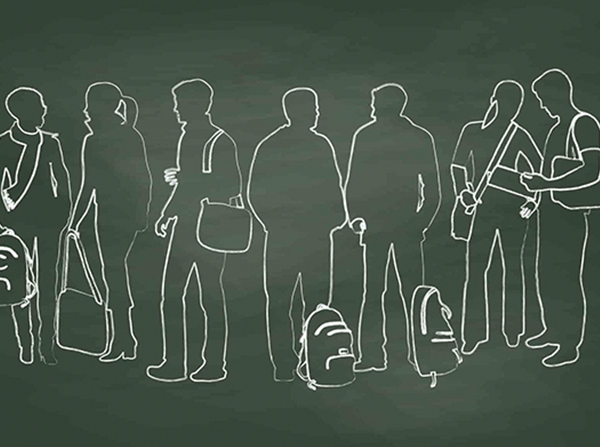
In Los Angeles County, 2,600 adolescents and young adults are diagnosed with cancer each year. (Illustration/iStock)
Outcomes for children and older adults with cancer have improved greatly over the past three decades, but there’s been little improvement in survival among adolescents and young adults with cancer.
That’s the finding of a Keck School of Medicine of USC report showing how overlooked this “middle-child” group is. But that reality is beginning to change at Keck Medicine of USC and elsewhere.
“Cancer survival data are poorly understood for 15- to 39-year-olds,” said Amie Hwang, PhD, assistant professor of clinical preventive medicine at the Keck School. “That makes it difficult for oncologists to accurately estimate, for example, how long a 29-year-old African-American man diagnosed with melanoma is expected to survive because we don’t have detailed cancer trends for this age group.”
Until now. Hwang and her colleagues at the Los Angeles Cancer Surveillance Program have published “Cancer in Los Angeles County: Survival Among Adolescents and Young Adults 1988-2014.” The report card is the first to break down cancer survival rates for 15- to 39-year-olds, USC researchers said. It breaks the data down to segments on race or ethnicity, sex, age group, socioeconomic status and cancer stage.
The National Cancer Institute released a cancer trends report for this “AYA” group nearly two decades ago. In addition to being dated, the report did not note how socioeconomic status may have an impact on health outcomes.
The new cancer report from the Keck School encompasses 18 of the most common cancers for 15- to 39-year-olds — about 80 percent of their diagnosed cancers. It includes data on Asians and Pacific Islanders, blacks, whites and Latinos.
“Adolescents and young adults go to the doctor less often because they have this superhero mentality, like they’re invincible,” said Dennis Deapen, DPH, senior author of the report and professor of clinical preventive medicine at the Keck School. “Once they do go to a health professional, their cancer diagnosis can be delayed because cancer isn’t the first concern doctors have for this age group. It comes as no surprise that patients diagnosed with late-stage cancer have reduced survival rates.”
Cancer is the leading cause of non-accidental death among 15- to 39-year-olds in the United States, according to the report.
The cancer download
About 87,000 adolescents and young adults are diagnosed with cancer in the U.S. each year, seven times more than the number of children and early teens diagnosed, the report noted. Pediatric oncologists are widespread, but AYA oncology is a budding research and clinical area.
In Los Angeles County, about 2,600 AYAs are diagnosed with cancer each year.
In total, the report includes 71,225 cancer cases diagnosed among 3.7 million AYAs who lived in Los Angeles County between 1988 and 2014.
The overarching message from this report is that 15- to 39-year-olds are hit by preventable cancers, Hwang said.
“Prevent cancer by taking charge of your health,” she said. “Screen for cancer, get the HPV vaccine, check for moles that are new or unusual, eat more fruit and vegetables, and exercise. Don’t forget to stay away from tobacco products and heavy drinking.”
Some of the report’s highlights:
- Colorectal cancer is on the rise among 15- to 39-year-olds even though the disease is on the decline for older populations. More sedentary lifestyles and poor diet may be a contributing factor, Hwang said. While colorectal screenings may benefit this group, the preventive measure currently is recommended only for people who are 50 or older.
- African-Americans experience the worst survival rates for most cancers, including breast, cervical, kidney and leukemia. Part of the reason for this trend may be the fact that they were the least likely to be diagnosed with cancer in a timely manner and do not receive appropriate treatment. It’s possible they had late-stage cancer by the time they were seen by doctors, Hwang said.
- Breast cancer is the most common cancer in AYA women and accounts for about 27 percent of their diagnosed cancers. Survival is generally lower for poorer people and for younger women because they generally have more aggressive forms of breast cancer. There is a lack of routine breast screening practices for this age group.
- AYA men have lower survival rates than AYA women for most of the cancers examined, except for breast, colorectal, stomach cancers and leukemia. Aside from inherent biological differences between men and women, men in this age group are less likely to seek routine medical care. The result is a delay in cancer detection.
- Cervical cancer has lower survival rates among blacks, older AYAs and people of low socioeconomic status. There is now a vaccine to prevent cervical cancer, which may account for why older AYAs have lower survival rates. Latinas (54 percent) and poor people (31 percent) are more likely to get cervical cancer because they are less likely to get screened.USC and Keck Medicine of USC are leaders in tackling intractable problems such as cancer. The Los Angeles Cancer Surveillance Program has tracked every diagnosed case of cancer in the region for the past 46 years. The Keck School and the USC Norris Comprehensive Cancer Center oversee this registry.
“Cancer in Los Angeles County: Survival Among Adolescents and Young Adults” was entirely funded by the federal government through grants from the National Cancer Institute, Centers for Disease Control and Prevention, California Cancer Registry and the Keck School of Medicine (T32CA09659, T32CA009492, 5NU58DP003862-04/DP003862, HHSN261201000140C, HHSN261201000035C, HHSN26120100034C).
— Zen Vuong